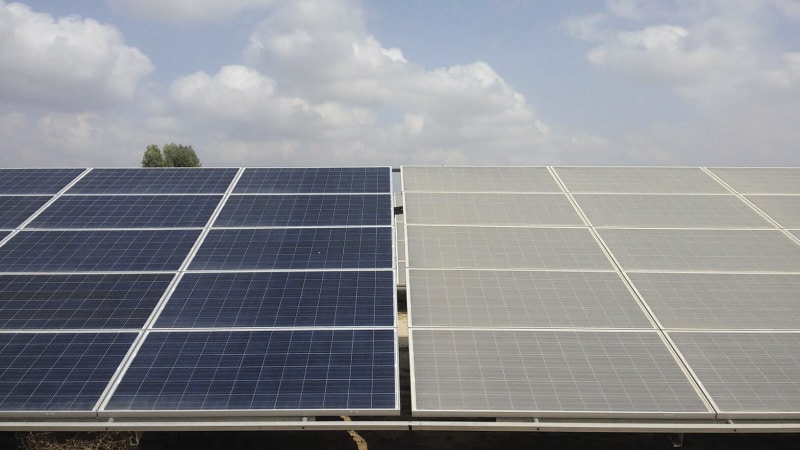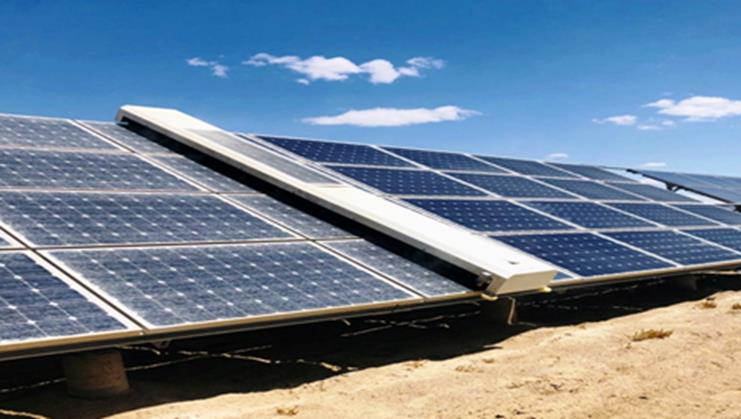What happens if the panels aren’t cleaned?
The East and North Africa are the most dusty parts of the world. Numerous experiments have been conducted around the world to measure the effect of dust on solar cells. In moderate dust conditions, the performance loss of PV systems due to dust deposition can be between 10% and 30%.
During sandstorms, nearly 68% of the power of PV modules is lost;

Effect of dust on the efficiency of solar panels
Chart of the monthly decrease in PV efficiency due to dust collection by country
| Country | Decreasing efficiency |
| Mexico | 13.0% |
| Iran | 80% |
| India | 75% |
| Egypt | 65% |
| Saudi Arabia | 60% |
| China | 26% |
| Oman | 15% |
| United States | 7.2% |
The best way to maintain a dusty solar plant is to use an Automated solar-panel cleaning machine. Cleaning once a day will not cause energy loss.

Automated solar panel cleaning robot cleaning dust benefit
High frequency clean, maximize power generation efficiency;
Uniform strength does not damage the solar panel;
Safe and efficient, no risk of injury;
No need to use labor, saving labor costs;
Clean once every morning, dust will not agglomerate, improve power generation efficiency and extend the life of solar panels;
No water, clean and environmentally friendly;
Effect of dust on solar panels
Atmospheric dust is one of the key factors affecting the efficiency of solar power generation. Dust pollution will significantly reduce the power generation of photovoltaic power stations, estimated to be at least 5% per year. If calculated according to the global installed capacity of about 600GW in 2024, the annual economic loss caused by dust reduction of power generation will be as high as $6 billion. This loss is expected to get worse as more power plants are installed – the economic cost of dust is expected to reach $13 billion in 2030, when the global installed capacity is approximately 1400GW.
output performance degradation
During the operation of solar photovoltaic power generation system, it will be affected by the dust in its environment. The photoelectric conversion efficiency of photovoltaic cells is related to the solar radiation intensity. Dust accumulation on the surface of photovoltaic panels will decrease the transmittance of the front cover glass, and the decline of transmittance will lead to the decline of the output performance of the battery. The greater the deposition concentration, the lower the transmittance, and the lower the amount of radiation absorbed by the panel, the greater the decline in output performance.
Loss of battery efficiency
During periods of low rain, the battery efficiency loss can reach more than 15% due to the accumulated dirt on the panel surface. The annual average power generation efficiency can be reduced by 6% due to the dirt and dust on the surface of the panel. In general, dust dirt in the air includes: dust, rain, pollutants, and their presence will lead to a reduction in the output energy of the battery. Because dust particles have a large effect on the forward scattering of sunlight, the current loss of this centralized module is usually much higher than that of the non-centralized one.
Corrosion of solar cell panels
The composition of dust is more complex, some acidic substances, some alkaline substances, and the main components of crystalline silicon photovoltaic panels are silica and limestone, if the dust meets the moisture in the air, it can produce acid or alkaline reaction with the composition of the panel. After a period of time, the surface of the photovoltaic panel is gradually corroded and damaged under the erosion of the acidic or alkaline environment, which makes the surface become pitted, resulting in the attenuation of the optical performance of the photovoltaic panel, and the diffuse reflection of solar radiation on the panel surface, which destroys the uniformity of solar radiation propagation in the photovoltaic panel.